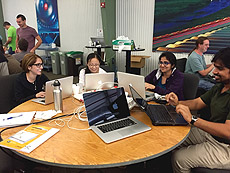First art/LArSoft course takes place at Fermilab
 |
These are four of the more than 50 experiment contributors who traveled from around the world to spend a week at Fermilab developing their skills at the first ever art/LArSoft course. Photo: Hanah Chang, OCIO |
Fermilab attracts visitors from around the world for collaborative research projects, to tour our one-of-a-kind science facilities and to see the bison herd. On Aug. 3-7, Fermilab added another reason to the list with the art/LArSoft course hosted by the Scientific Computing Division.
The week-long course quickly reached maximum capacity with 50 participants from many different experiments traveling to Fermilab from Brazil, Italy, Poland and throughout the United States.
This was the first ever LArSoft course, and its popularity was due in part to a growing need for trained developers in art and LArSoft.
The first four days of the course, led by SCD's Marc Paterno, focused on learning art, an event-processing framework for particle physics experiments. The last day, led by SCD's Erica Snider, covered the LArSoft suite, which allows data structures, algorithms and tools to be shared across liquid-argon-based neutrino experiments to efficiently and effectively gather and understand data from the particle detectors.
"This course, and LArSoft in general, is an opportunity to collaborate between experiments in a way that has never been done before," Snider said. "Each experiment will build on the previous one, and this collaboration will lower the costs of developing the software."
With only a few days to cover significant amounts of information, the instructors viewed the course as a chance to highlight the software's more helpful bits and pieces, giving the participants a jumping-off point for further study.
"Even if I was familiar with C++, I think it would take me a lot more than five days, more like months, to learn everything by myself even with the documentation," said Gustavo Valdiviesso, a professor at Federal University of Alfenas in Brazil who is working on the DUNE, LArIAT and SBND experiments. "Now I know where to start and which direction I want to go."
Both instructors and participants expressed hope that there will be similar courses in the future, with a multiday course dedicated to LArSoft.
—Hanah Chang and Hannah Ward
|